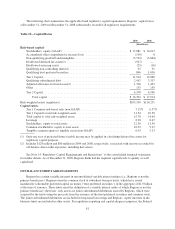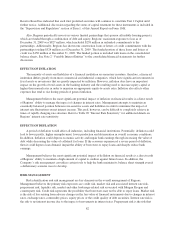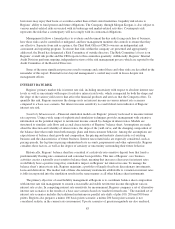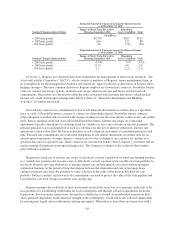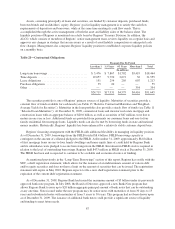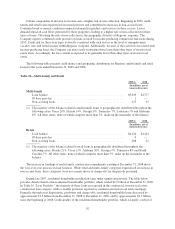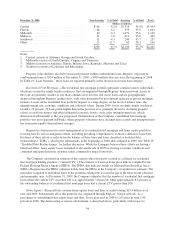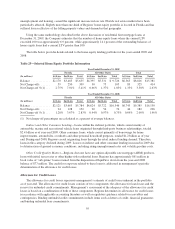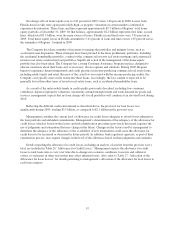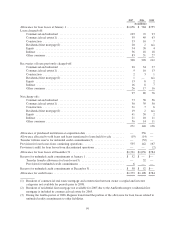Regions Bank 2009 Annual Report Download - page 103
Download and view the complete annual report
Please find page 103 of the 2009 Regions Bank annual report below. You can navigate through the pages in the report by either clicking on the pages listed below, or by using the keyword search tool below to find specific information within the annual report.Interest rate risk at Morgan Keegan arises from the exposure of holding interest-sensitive financial
instruments such as government, corporate and municipal bonds, and certain preferred equities. Morgan Keegan
manages its exposure to interest rate risk by setting and monitoring limits and, where feasible, entering into
offsetting positions in securities with similar interest rate risk characteristics. Securities inventories recorded in
trading account assets on the consolidated balance sheets, are marked to market, and, accordingly, there are no
unrecorded gains or losses in value. While a significant portion of the securities inventories have contractual
maturities in excess of five years, these inventories, on average, turn over in excess of twelve times per year.
Accordingly, the exposure to interest rate risk inherent in Morgan Keegan’s securities inventories is less than that
of similar financial instruments held by firms in other industries. Morgan Keegan’s equity securities inventories
are exposed to risk of loss in the event of unfavorable price movements. Also, Morgan Keegan is subject to credit
risk arising from non-performance by trading counterparties, customers and issuers of debt securities owned.
This risk is managed by imposing and monitoring position limits, monitoring trading counterparties, reviewing
security concentrations, holding and marking to market collateral, and conducting business through clearing
organizations that guarantee performance. Morgan Keegan regularly participates in the trading of some
derivative securities for its customers; however, this activity does not involve Morgan Keegan acquiring a
position or commitment in these products and this trading is not a significant portion of Morgan Keegan’s
business.
To manage trading risks arising from interest rate and equity price risks, Regions uses a Value at Risk
(“VAR”) model along with other risk management methods to measure the potential fair value the Company
could lose on its trading positions given a specified statistical confidence level and time-to-liquidate time
horizon. The end-of-period VAR was approximately $1 million at both December 31, 2009 and December 31,
2008. Maximum daily VAR utilization during 2009 was $3 million and average daily VAR during the same
period was $2 million.
Morgan Keegan has been an underwriter and dealer in auction rate securities. See Note 24 “ Commitments
and Contingencies” to the consolidated financial statements as well as Item 3. “Legal Proceedings” of Part I for
more details regarding regulatory action related to Morgan Keegan auction rate securities. As of December 31,
2009, customers of Morgan Keegan owned approximately $247 million of auction rate securities, and Morgan
Keegan held approximately $166 million of auction rate securities on the balance sheet.
COUNTERPARTY RISK
Regions manages and monitors its exposure to other financial institutions, also known as counterparty
exposure, on an ongoing basis. The objective is to ensure that Regions appropriately identifies and reacts to risks
associated with counterparties in a timely manner. This exposure may be direct or indirect exposure that could
create legal, reputational or financial risk to the Company.
Counterparty exposure may result from a variety of transaction types and may include exposure to
commercial banks, savings and loans, insurance companies, broker/dealers, institutions that provide credit
enhancements, and corporate debt issuers. Because transactions with a counterparty may be generated in one or
more departments, credit limits are established for use by various areas of the Company including treasury,
capital markets, finance, the mortgage division and lines of business.
To manage counterparty risk, Regions has a centralized approach to approval, management and monitoring
of exposure. To that end, Regions has a dedicated counterparty credit group and credit officer, as well as a
documented counterparty credit policy. Exposures to counterparties are regularly aggregated across departments
and reported to senior management.
CREDIT RISK
Regions’ objective regarding credit risk is to maintain a high-quality credit portfolio that provides for stable
credit costs with acceptable volatility through an economic cycle.
89




